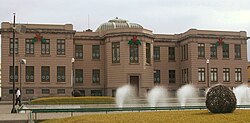History
Originally, this site contained a college for the Jesuit order ("Colegio Jesuita de Nuestra Señora de Loreto", or Jesuit College of Our Lady of Loreto); however, in 1767 the Jesuits were expelled from all of the crown territories of Spain, following the orders of King Charles III, and the building was left abandoned. It later was converted into a 'Royal Military Hospital' and it was during this time that Fr Hidalgo was imprisoned there.
In 1878, the college was razed to the ground (except the tower in which Hidalgo was imprisoned, by decree of President Benito Juárez; it is now in the basement, but originally it was at ground level), and the Casa de Moneda, or branch mint was built here, where for some time Chihuahua minted and printed her own currency. In 1908 the Casa de Moneda was demolished in order to erect the Federal Palace that finally was inaugurated in 1910, during the celebrations of the centenary of Mexico's independence.
The Palace was built originally to concentrate all the offices of the Federal Government in the same place. During the revolution, Abraham Gonzalez, the deposed Governor of Chihuahua and political mentor of Pancho Villa was imprisoned there by order of the unconstitutional then-president and dictator Victoriano Huerta. He would eventually be murdered on Huerta's orders. The Palace also served as the main office of the Federal Postal Service (since it was a federal office) in Chihuahua.
In 2004 the postal service left the building and the palace was re-modeled in order to inaugurate a museum that would be called the Casa Chihuahua Centro de Patrimonio Cultural. It opened its doors again in 2006 and is today one of the most famous landmarks in the city, serving as a centre of culture in the city.

Zacatecas is the principal city within the municipality in Mexico of the same name, and the capital and the largest city of the state of Zacatecas. Located in north-central Mexico, the city had its start as a Spanish mining camp in the mid-16th century. Native Americans had already known about the area's rich deposits of silver and other minerals. Due to the wealth that the mines provided, Zacatecas quickly became one of the most important mining cities in New Spain. The area saw battles during the turbulent 19th century, but the next major event was the Battle of Zacatecas during the Mexican Revolution when Francisco Villa captured the town, an event still celebrated every anniversary. Today, the colonial part of the city is a World Heritage Site, due to the Baroque and other structures built during its mining days. Mining still remains an important industry. The name Zacatecas is derived from the Zacateco people and has its roots in Nahuatl. The name means "people of the grasslands".
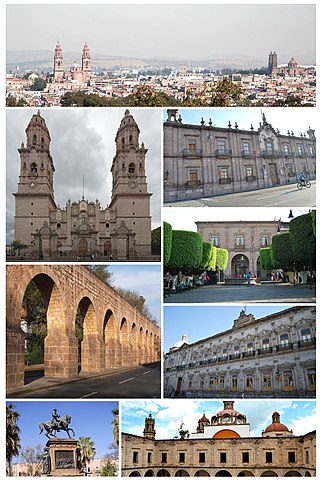
Morelia is a city and municipal seat of the municipality of Morelia in the north-central part of the state of Michoacán in central Mexico. The city is in the Guayangareo Valley and is the capital and largest city of the state. The main pre-Hispanic cultures here were the Purépecha and the Matlatzinca, but no major cities were founded in the valley during this time. The Spanish took control of the area in the 1520s. The Spanish under Viceroy Antonio de Mendoza founded a settlement here in 1541 with the name of Valladolid, which became rival to the nearby city of Pátzcuaro for dominance in Michoacán. In 1580, this rivalry ended in Valladolid's favor and it became the capital of the viceregal province. After the Mexican War of Independence, the city was renamed Morelia in honor of José María Morelos, who hailed from the city. In 1991, the city was declared a UNESCO World Heritage Site for its well-preserved historical buildings and layout of the historic center. It is tradition to name people born on September 30 after the city. The city population in 2020 was 743,275 inhabitants. The municipality had 849,053 inhabitants, and the Metropolitan Area, composed of Morelia, Tarímbaro, and Charo municipalities, had 988,704 inhabitants, according to the XIV Census.

The city of Chihuahua(La Ciudad de Chihuahua) is the state capital of the Mexican state of Chihuahua. As of 2020, the city of Chihuahua had a population of 925,762 inhabitants. while the metropolitan area had a population of 988,065 inhabitants.

Palacio de La Moneda, or simply La Moneda, is the seat of the President of the Republic of Chile. It also houses the offices of three cabinet ministers: Interior, General Secretariat of the Presidency and General Secretariat of the Government. It occupies an entire block in downtown Santiago, in the area known as Civic District between Moneda, Morandé (East), Alameda del Libertador Bernardo O'Higgins (South) and Teatinos street (West).
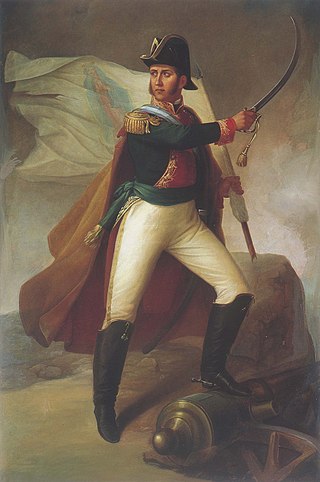
Ignacio José de Allende y Unzaga, commonly known as Ignacio Allende, was a captain of the Spanish Army in New Spain who came to sympathize with the Mexican independence movement. He attended the secret meetings organized by Josefa Ortiz de Domínguez, where the possibility of an independent Mexico was discussed. He fought along with Miguel Hidalgo y Costilla in the first stage of the struggle, eventually succeeding him in leadership of the rebellion. Allende was captured by Spanish colonial authorities while he was in Coahuila and executed for treason in Chihuahua.

San Ángel is a colonia or neighborhood of Mexico City, located in the southwest in Álvaro Obregón borough. Historically, it was a rural community, called Tenanitla in the pre-Hispanic period. Its current name is derived from the El Carmen monastery school called San Ángel Mártir. San Ángel remained a rural community, centered on the monastery until the 19th and 20th centuries, when the monastery was closed and when the area joined urban sprawl of Mexico City. However, the area still contains many of its former historic buildings and El Carmen is one of the most visited museums in the city. It is also home to an annual flower fair called the Feria de las Flores, held since 1856.

The National Museum of Anthropology is a national museum of Mexico. It is the largest and most visited museum in Mexico. Located in the area between Paseo de la Reforma and Mahatma Gandhi Street within Chapultepec Park in Mexico City, the museum contains significant archaeological and anthropological artifacts from Mexico's pre-Columbian heritage, such as the Stone of the Sun and the Aztec Xochipilli statue.

The historic center of Mexico City, also known as the Centro or Centro Histórico, is the central neighborhood in Mexico City, Mexico, focused on Zócalo or main plaza and extending in all directions for a number of blocks, with its farthest extent being west to the Alameda Central. The Zocalo is the largest plaza in Latin America. It can hold up to nearly 100,000 people.
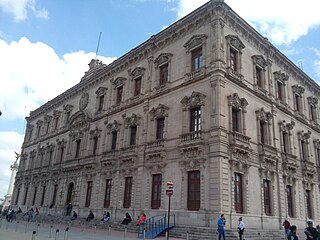
The Government Palace of Chihuahua is a 19th-century building in the city of Chihuahua, Mexico. Located in the heart of the city, it is of special interest since it houses the executive offices of the governor of the state of Chihuahua and, until 2004, the state legislature met here. The building is a landmark in the city as it contains a shrine commemorating the execution of Miguel Hidalgo, considered the Father of the Country, who died at the hands of a Spanish firing squad on July 30, 1811. The Altar de la Patria, or Altar of the Fatherland is located at the exact spot where Miguel Hidalgo died.
Juan Bautista de las Casas led a revolt against the governor of Spanish Texas in 1811 and served as head of the province for 39 days until he was deposed.

The Museo de la Lealtad Republicana, also known as the Museo Casa Juárez, is a 19th-century building in the city centre of Chihuahua, Mexico. It housed the constitutional government of President Benito Juárez during his stay in Chihuahua while Maximilian of Habsburg reigned as Emperor of Mexico, supported by the French, and was thus the de facto National Palace of Mexico.

The Museo Nacional de las Culturas is a national museum in Mexico City dedicated to education about the world's cultures, both past and present. It is housed in a colonial-era building that used to be the mint for making coins. Prior to this, the site was the home of the location of the Moctezuma's Black House. The mint was moved to Apartado Street in 1850, and the building was used for various purposes until it was converted to its current use in 1966.
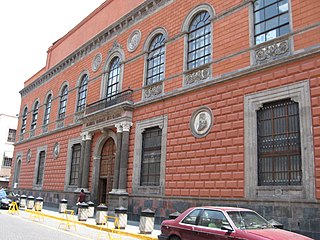
The Academy of San Carlos is located at 22 Academia Street in just northeast of the main plaza of Mexico City. It was the first major art academy and the first art museum in the Americas. It was founded in 1781 as the School of Engraving and moved to the Academia Street location about 10 years later. It emphasized classical European training until the early 20th century, when it shifted to a more modern perspective. At this time, it also integrated with the National Autonomous University of Mexico, eventually becoming the Faculty of Arts and Design, which is based in Xochimilco. Currently, only graduate courses of the modern school are given in the original academy building.
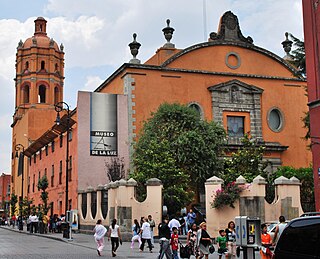
The San Pedro y San Pablo College is a colonial church and located in the historical center of Mexico City, Mexico.

Chihuahua, officially the Free and Sovereign State of Chihuahua, is one of the 31 states which, along with Mexico City, comprise the 32 federal entities of Mexico. It is located in the northwestern part of Mexico and is bordered by the states of Sonora to the west, Sinaloa to the southwest, Durango to the south, and Coahuila to the east. To the north and northeast, it shares an extensive border with the U.S. adjacent to the U.S. states of New Mexico and Texas. Its capital city is Chihuahua City; the largest city is Ciudad Juárez.

In 2010, Mexico celebrated both the 200th anniversary of its Independence and 100th anniversary of its Revolution. The entire year was proclaimed by President Felipe Calderón as "Año de la Patria", or "Year of the Nation". 16 September 1810 is the day of the "Grito de Dolores" or Miguel Hidalgo's call to take up arms against the Spanish colonial government. The start of the Mexican Revolution is celebrated as being 20 November 1910, when Francisco "Pancho" Villa and Pascual Orozco led the first insurrectionist attack against the regime of Porfirio Díaz. Events and other promotions of these celebrations were designed to link of Mexico's identity and historic continuity. During a speech at the inauguration of the Casa de Allende Historic Museum, President Felipe Calderón called upon Mexico to use the upcoming anniversaries to reflect on where the country has been and to think about what kind of Mexico descendants will inherit in the future. He said the vision of the insurgents of the War of Independence was forward, not backward, so every celebration of these past events must consider the future as well.

The Palacio de la Autonomía is a museum and site where the Universidad Nacional Autónoma de México gained autonomy from direct government control in 1929. The building is from the late 19th century, and located on the corner of Licenciado de Verdad and Rep de Guatemala streets, north of Santa Teresa la Antigua and east of Templo Mayor. The site has a 500-year history, starting from part of lands granted by Hernán Cortés. The current building was constructed by the administration of President Porfirio Díaz, but it was ceded to the university in 1910. Since that time, the building has had a number of uses, including housing a dental school and a preparatory school. Today it houses the Museo de la Autonomía Universitaria.
Casa de la Moneda or Casa de Moneda is Spanish for mint (coin) and is the name of many buildings and institutions:
The following is a timeline of the history of the city of Chihuahua, Mexico.



